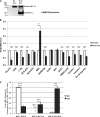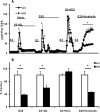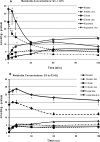Mitochondrial dysfunction contributes to impaired insulin secretion in INS-1 cells with dominant-negative mutations of HNF-1alpha and in HNF-1alpha-deficient islets
- PMID: 19376774
- PMCID: PMC2719317
- DOI: 10.1074/jbc.M807723200
Mitochondrial dysfunction contributes to impaired insulin secretion in INS-1 cells with dominant-negative mutations of HNF-1alpha and in HNF-1alpha-deficient islets
Abstract
Maturity Onset Diabetes of the Young-type 3 (MODY-3) has been linked to mutations in the transcription factor hepatic nuclear factor (HNF)-1alpha, resulting in deficiency in glucose-stimulated insulin secretion. In INS-1 cells overexpressing doxycycline-inducible HNF-1alpha dominant-negative (DN-) gene mutations, and islets from Hnf-1alpha knock-out mice, insulin secretion was impaired in response to glucose (15 mm) and other nutrient secretagogues. Decreased rates of insulin secretion in response to glutamine plus leucine and to methyl pyruvate, but not potassium depolarization, indicate defects specific to mitochondrial metabolism. To identify the biochemical mechanisms responsible for impaired insulin secretion, we used (31)P NMR measured mitochondrial ATP synthesis (distinct from glycolytic ATP synthesis) together with oxygen consumption measurements to determine the efficiency of mitochondrial oxidative phosphorylation. Mitochondrial uncoupling was significantly higher in DN-HNF-1alpha cells, such that rates of ATP synthesis were decreased by approximately one-half in response to the secretagogues glucose, glutamine plus leucine, or pyruvate. In addition to closure of the ATP-sensitive K(+) channels with mitochondrial ATP synthesis, mitochondrial production of second messengers through increased anaplerotic flux has been shown to be critical for coupling metabolism to insulin secretion. (13)C-Isotopomer analysis and tandem mass spectrometry measurement of Krebs cycle intermediates revealed a negative impact of DN-HNF-1alpha and Hnf-1alpha knock-out on mitochondrial second messenger production with glucose but not amino acids. Taken together, these results indicate that, in addition to reduced glycolytic flux, uncoupling of mitochondrial oxidative phosphorylation contributes to impaired nutrient-stimulated insulin secretion with either mutations or loss of HNF-1alpha.
Figures








Similar articles
-
Dominant-negative suppression of HNF-1alpha function results in defective insulin gene transcription and impaired metabolism-secretion coupling in a pancreatic beta-cell line.EMBO J. 1998 Nov 16;17(22):6701-13. doi: 10.1093/emboj/17.22.6701. EMBO J. 1998. PMID: 9822613 Free PMC article.
-
Hepatocyte nuclear factor 4alpha regulates the expression of pancreatic beta -cell genes implicated in glucose metabolism and nutrient-induced insulin secretion.J Biol Chem. 2000 Nov 17;275(46):35953-9. doi: 10.1074/jbc.M006612200. J Biol Chem. 2000. PMID: 10967120
-
Hepatocyte nuclear factor-1alpha modulates pancreatic beta-cell growth by regulating the expression of insulin-like growth factor-1 in INS-1 cells.Diabetes. 2002 Jun;51(6):1785-92. doi: 10.2337/diabetes.51.6.1785. Diabetes. 2002. PMID: 12031966
-
Exploring the role of the HNF-1αG319S polymorphism in β cell failure and youth-onset type 2 diabetes: Lessons from MODY and Hnf-1α-deficient animal models.Biochem Cell Biol. 2015 Oct;93(5):487-94. doi: 10.1139/bcb-2015-0021. Epub 2015 May 6. Biochem Cell Biol. 2015. PMID: 26176428 Review.
-
Beta-cell mitochondria in the regulation of insulin secretion: a new culprit in type II diabetes.Diabetologia. 2000 Mar;43(3):265-77. doi: 10.1007/s001250050044. Diabetologia. 2000. PMID: 10768087 Review.
Cited by
-
Is Type 2 Diabetes a Primary Mitochondrial Disorder?Cells. 2022 May 12;11(10):1617. doi: 10.3390/cells11101617. Cells. 2022. PMID: 35626654 Free PMC article. Review.
-
Hepatocyte Nuclear Factor-1β Controls Mitochondrial Respiration in Renal Tubular Cells.J Am Soc Nephrol. 2017 Nov;28(11):3205-3217. doi: 10.1681/ASN.2016050508. Epub 2017 Jul 24. J Am Soc Nephrol. 2017. PMID: 28739648 Free PMC article.
-
Fuel-Stimulated Insulin Secretion Depends upon Mitochondria Activation and the Integration of Mitochondrial and Cytosolic Substrate Cycles.Diabetes Metab J. 2011 Oct;35(5):458-65. doi: 10.4093/dmj.2011.35.5.458. Epub 2011 Oct 31. Diabetes Metab J. 2011. PMID: 22111036 Free PMC article.
-
Differences in glucose-stimulated insulin secretion in vitro of islets from human, nonhuman primate, and porcine origin.Xenotransplantation. 2013 Mar-Apr;20(2):75-81. doi: 10.1111/xen.12022. Epub 2013 Feb 5. Xenotransplantation. 2013. PMID: 23384163 Free PMC article.
-
Novel Loss-of-Function Variant in HNF1a Induces β-Cell Dysfunction through Endoplasmic Reticulum Stress.Int J Mol Sci. 2022 Oct 27;23(21):13022. doi: 10.3390/ijms232113022. Int J Mol Sci. 2022. PMID: 36361808 Free PMC article.
References
-
- Fajans S. S. ( 1989) Diabetes Metab. Rev. 5, 579– 606 - PubMed
-
- Yamagata K., Oda N., Kaisaki P. J., Menzel S., Furuta H., Vaxillaire M., Southam L., Cox R. D., Lathrop G. M., Boriraj V. V., Chen X., Cox N. J., Oda Y., Yano H., Le Beau M. M., Yamada S., Nishigori H., Takeda J., Fajans S. S., Hattersley A. T., Iwasaki N., Hansen T., Pederson O., Polonsky K. S., Bell G. I., et al. ( 1996) Nature 384, 455– 458 - PubMed
-
- Dukes I. D., Sreenan S., Roe M. W., Levisetti M., Zhou Y. P., Ostrega D., Bell G. I., Pontoglio M., Yaniv M., Philipson L., Polonsky K. S. ( 1998) J. Biol. Chem. 273, 24457– 24464 - PubMed
-
- Shih D. Q., Screenan S., Munoz K. N., Philipson L., Pontoglio M., Yaniv M., Polonsky K. S., Stoffel M. ( 2001) Diabetes 50, 2472– 2480 - PubMed
Publication types
MeSH terms
Substances
Grants and funding
LinkOut - more resources
Full Text Sources
Medical

